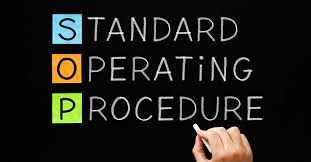
Articles
How to Create a Standard Operating Procedure: Find Out Now!

Creating standard operating procedures can be an intimidating task for small-to-medium-sized businesses, but with the right steps, you can create standard operating procedures that will help streamline your processes and ensure success. From defining what an SOP is to developing, implementing, and maintaining them — we'll show you how to create a standard operating procedure in no time. So let's get started on how to create a standard operating procedure for your business today.
Defining Standard Operating Procedures (SOPs)
A Standard Operating Procedure is a written document that outlines the steps necessary for completing specific tasks or activities within an organization. It should include detailed instructions on how to complete each task accurately and efficiently while also providing clear guidance on when it should be completed by. The goal of SOPs is to guarantee consistent outcomes across all divisions in the firm, so everyone knows precisely what they should do without requiring more guidance or explanation from supervisors or leadership.
Benefits of SOPs
Developing standard operating procedures helps reduce errors and confusion among staff members who may not have prior experience with certain tasks or activities. This leads to improved productivity since employees don’t need additional training every time there’s a new project or initiative underway — they already know what needs to be done based on their understanding of the existing procedures outlined in the SOP document(s).
Additionally, well-defined processes help streamline decision-making since everyone involved will have access to accurate information about how things should be handled which eliminates guesswork from the equation altogether. Finally, developing standard operating procedures also makes it easier for organizations to stay compliant with industry regulations since all relevant laws/regulations are documented within these documents too.
Ultimately, all these types of SOPs serve one common goal: helping businesses achieve more tremendous success through efficient operations management. Creating standard operating procedures can be a great asset for businesses, providing them with regularity, quality assurance, and productivity. With a clear understanding of SOPs in place, it is now time to write standard operating procedures that will help you grow and scale your business.
Developing Your SOPs
To ensure consistency and clarity in task completion, it is essential how to create a standard operating procedure with step-by-step instructions for each process identified as needing documentation. This will ensure consistency in how tasks are completed and help employees understand what’s expected of them. You may also lookup standard operating procedure examples to help give an idea of a perfect SOP for your business.

Identifying Processes To Document
The first step on how to create a standard operating procedure is to identify which processes should be documented as SOPs. Start by looking at the most frequently performed tasks within your organization and those with potential risks or liabilities if done incorrectly.
You may also want to look at areas where there have been complaints or problems in the past, as well as any new policies you’ve recently implemented. Once you’ve identified which processes should be documented, move on to writing them down.
Writing The Procedure Step-By-Step
When thinking about how to create a standard operating procedure, make sure each step is clearly written out so that anyone can follow along without confusion or ambiguity. Try breaking down complex tasks into smaller steps and use action words like “open”, “close”, “click” etc., when applicable. Also, include any safety precautions or warnings necessary for completing certain steps correctly — this will help prevent accidents from occurring while following your procedure manual.
Testing And Refining Your SOPs
Once you have all of your procedures written out, test them out yourself before having others do so too. Make sure they make sense logically and don't require any extra steps not mentioned in the document itself — this could lead to confusion later on when someone else reads through it.
After testing everything out yourself once more time, ask a few other people who work closely with these procedures (such as supervisors or managers) for their feedback on how things can be improved upon even further before officially implementing them across the board within your organization.
Developing standard operating procedures is a crucial step in ensuring that all processes are documented accurately and efficiently. To ensure the successful implementation of these procedures, it's important to establish accountability for following them and measure compliance with the new standards.
Implementing Your SOPs
Training employees on new procedures is essential for the successful implementation of SOPs. Employees should be given comprehensive standard operating procedures on-hand, along with explicit directions on how to execute assignments correctly. Training sessions should be tailored to each employee’s role and responsibilities, with additional training provided if needed.
To ensure that everyone understands the material, consider using interactive activities such as quizzes or simulations. Additionally, it can be helpful to have employees sign a document indicating they understand their roles and are committed to following the SOPs in place.
Establishing accountability for following procedures helps ensure that everyone is held responsible for doing their part when it comes to adhering to your SOPs. Start by assigning specific people responsible for certain processes or tasks; this will help you track who is accountable at any given time. You can also create incentives or rewards systems based on compliance with SOPs — these could range from verbal recognition during team meetings or performance reviews, all the way up to bonuses and other financial rewards depending on your budget and goals.
Ensuring that all staff are equipped with the knowledge of how to use the new regulations and held responsible for adhering to them is essential for the successful execution of your SOPs. Regularly assessing and modifying existing practices is essential for sustaining the efficacy of these policies.
Maintaining and Updating Your SOPs
Regularly reviewing and updating SOPs is essential for keeping a business running smoothly. Regular reviews should be scheduled to ensure procedures are up-to-date with the latest technology or regulations, and that all employees are aware of any changes.
Scheduling periodic check-ins can guarantee that all personnel in your business are aware of and following the set rules. For example, if there's a new regulation regarding customer privacy, scheduling regular reviews will help you make sure your team is updated on what needs to be done in order to comply with this regulation.
Making changes as needed can help keep up with changes in technology or regulations so that your business stays competitive and compliant. This could include introducing new software systems or updating processes for data security compliance — whatever it takes to keep up with industry standards while still meeting customer expectations.
Taking advantage of automation tools can also make keeping track of updates easier; for instance, using automated alerts for any policy updates allows teams across departments to stay informed without having someone manually check each document every day.
Finally, ensuring all employees are aware of updated procedures helps create consistency throughout the organization so everyone understands how things work from top-to-bottom within the company structure. This means setting aside time during staff meetings or training sessions where these updates can be discussed openly and honestly, allowing everyone involved (including managers) a chance to ask questions about any changes being made before they're implemented into practice. Additionally, making sure all documents related to SOPs are easily accessible online through an internal system like SharePoint makes them easy for anyone who needs access at any time from anywhere around the world.
FAQs in Relation to How to Create a Standard Operating Procedure
How do you create a standard operating procedure?
Formulating an SOP requires the specification of stages and processes required to execute an activity. It should include details such as roles and responsibilities, resources needed, timing expectations, and any other relevant information.
The SOP should be written in an organized manner that is easy to understand for all involved parties. It is essential to periodically evaluate the SOPs for precision and pertinence as business requirements fluctuate in time.
What is SOP and how do you write it?
Standard Operating Procedures (SOPs) are detailed written instructions to help ensure consistent performance of a task or process. SOPs provide a roadmap for accomplishing tasks, including safety measures, resources needed, desired outcomes, and quality assurance protocols.
In writing standard operating procedures, it is essential to be precise and succinct in order for the instructions to be understood properly. Start by outlining the goal of the procedure followed by each step that should be taken in chronological order; then explain any special considerations that need to be made when completing the steps. Finally, add any relevant notes or warnings so that users can properly follow through with their tasks without risk of injury or harm.
Conclusion
Learning how to create a standard operating procedure will help businesses to achieve success along the line. Having comprehensive standard operating procedures on-hand can help employees to be less dependent when it comes to performing tasks. By creating clear guidelines for each process or task within your organization, you will be able to set yourself up for success now and in the future.
Sign up now for a free 7-day trial with Trainual and scale your business!
Similar Blog Posts







